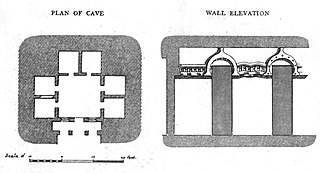
The Kelaniya Raja Maha Vihara or Kelaniya Temple is a Buddhist temple in Kelaniya, Sri Lanka, seven miles from Colombo. The Chief Incumbent is Venerable Professor Kollupitiye Mahinda Sangharakkhitha Thera.
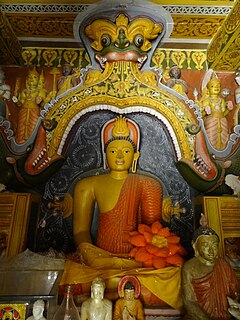
Embekka Devalaya was built by the King Vikramabahu III of Gampola Era in Sri Lanka. The devalaya is dedicated to the worship of Mahasen, popularly known as Kataragama deviyo. A local deity called Devatha Bandara is also worshiped at this site. The shrine consists of three sections, the "Sanctum of Garagha", the "Digge" or "Dancing Hall" and the "Hevisi Mandapaya" or the "Drummers' Hall". The Drummers' Hall that has drawn the attention of visitors to the site, due to the splendid wood carvings of its ornate pillars and its high pitched roof.

Udugampola is a small town in the Gampaha District of Sri Lanka and was a sub kingdom during reign of the King Sakala Kala Wallabha of Kotte Era. The main point in the area is around the intersection of Gampaha-Minuwangoda and Kotugoda-Naiwala roads.

Bellanwila Rajamaha Viharaya is a Buddhist temple situated in Bellanwila, Colombo District, Sri Lanka. Located around 12 km south to the Colombo city, near Dehiwala - Maharagama road, the temple attracts hundreds of devotees daily and is famous for its annual Esala Perehera festival which usually takes place in the month of August or September. One of the most venerated Buddhist temples in Sri Lanka, many devotees flock to worship the sacred Bo tree of Bellanwila Rajamaha Vihara, which is considered to be one of the first offshoots of Jaya Sri Maha Bodhi in Anuradhapura, Sri Lanka. The present chief incumbent of Bellanwila Rajamaha Vihara is Ven. Bellanwila Dhammaratana Nayaka Thera.
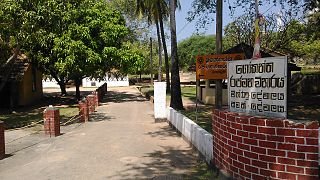
Gokanna Viharaya was an ancient Buddhist temple located in Trincomalee in the Eastern Province of Sri Lanka. The temple lies in the premises of Fort Fredrick close to the fort entrance.

Dewalapola is a small rural area in Minuwangoda Divisional Secretariate of Gampaha District, Western Province, Sri Lanka. It is situated on the 245/1 Nittambuwa - Katunayake / Airport bus route between Veyangoda and Minuwangoda.
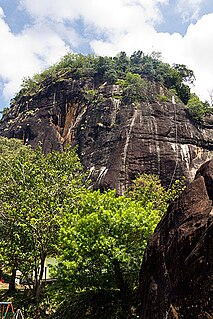
Mulkirigala Raja Maha Vihara is an ancient Buddhist temple in Mulkirigala, Sri Lanka. It has been built on a 205 m (673 ft) high natural rock, surrounded with another four rocks known as Benagala, Kondagala, Bisogala and Seelawathiegala. The temple site is located about 2 km (1.2 mi) from the Mulkirigala junction and can be reached from either Dikwella or Tangalle towns. The temple has been formally recognised by the Government as an archaeological site in Sri Lanka. The designation was declared on 8 April 1988 under the government Gazette number 501.

Kadurugoda Viharaya is an ancient Buddhist temple situated in Chunnakam, Jaffna District, Sri Lanka. The temple is located in a small hamlet called Kandarodai and it is one of the few Buddhist temples remaining in Jaffna today. Currently this temple has been declared as an archaeological site in Sri Lanka and is maintained by the Sri Lankan army.

Aluthepola Ganekanda Raja Maha Vihara is an old Buddhist temple in Minuwangoda, Sri Lanka. According to the regional folklore this temple is believed to be one of places where King Valagamba spent his time when five Dravidian were ruling Anuradhapura. The temple has been formally recognised by the Government as an archaeological site in Sri Lanka. The designation was declared on 22 November 2002 under the government Gazette number 1264.

Maligatenna Raja Maha Vihara is an ancient Cave temple which is located in Malwatuhiripitiya village, Gampaha District, Sri Lanka. The temple is located on the Gampaha - Wathurugama Road and approximately 1.6 km (0.99 mi) away from the ancient temple Pilikuththuwa Raja Maha Vihara.

Pilikuththuwa Raja Maha Vihara is an ancient Cave temple situated in Pilikuththuwa, Sri Lanka. It is located on the Gampaha - Wathurugama road approximately 3.8 km (2.4 mi) away from the Miriswatta junction and 1.6 km (0.99 mi) from the ancient Buddhist temple, Maligatenna Raja Maha Vihara. The temple has been formally recognised by the Government as an archaeological site in Sri Lanka.

Gonagolla Vihara is an ancient Cave temple situated in Ampara District, Sri Lanka. The Vihara is also known as punchi Seegiriya by the locals since the temple contain ancient frescoes similar to Sigiriya. The site is in Kotmale Canal Settlement in Wewagampattuwa Division and lies about 4.8 km (3.0 mi) east of Kohombana Junction on Ampara – Gonagolla Road. The temple has been formally recognised by the Government as an archaeological site in Sri Lanka. The designation was declared on 10 October 2014 under the government Gazette number 1884.
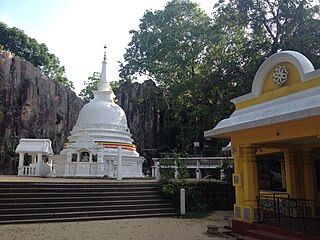
Koskandawala Sri Sunandarama Piriven Raja Maha Vihara is an old Buddhist temple in Koskandawala, Sri Lanka. The temple is located on Yakkala – Radawana road approximately 2.66 km away from Yakkala town. The temple has been formally recognized by the Government as an archaeological site in Sri Lanka.
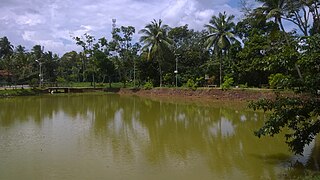
Pathaha Pokuna is an ancient bathing tank or pool situated in Udugampola, Sri Lanka. It is located approximately 0.45 km (0.28 mi) from Udugampola Roundabout and close to the historic temple Uththararama Purana Vihara. The pond has been formally recognised by the Government as an archaeological protected monument in Sri Lanka. The designation was declared on 8 July 2005 under the government Gazette number 1401.

Uththararama Purana Vihara is a historic Buddhist temple situated at Udugampola in the Western province, Sri Lanka. The temple is located on Udugampola – Weediyawatta junction road approximately 0.5 km (0.31 mi) away from the Udugampola Roundabout. The temple has been formally recognised by the Government as an archaeological site in Sri Lanka. The designation was declared on 7 July 2005 under the government Gazette number 1401.

Kshetrarama Maha Vihara is a historic Buddhist temple situated in Moratuwa, Sri Lanka. It is located in the Lakshapathiya area, approximately 1.2 km (0.75 mi) from Katubedda junction on Colombo-Galle main road (A2). The temple has been formally recognized by the Government as an archaeological site in Sri Lanka.

Panasawanarama Purana Vihara is a Buddhist temple in Kospillewa, Sri Lanka. The temple is located on Udugampola – Divulapitiya road approximately 2 km (1.2 mi) away from Udugampola town. The temple has been formally recognised by the Government as an archaeological site in Sri Lanka. The designation was declared on 22 November 2002 under the government Gazette number 1264.
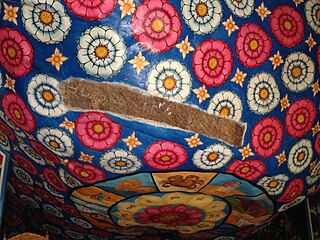
Uththara Jayamaha Vihara is an ancient Buddhist temple in Hingurana, Sri Lanka. The temple has been formally recognised by the Government as an archaeological site in Sri Lanka. The designation was declared on 26 December 2014 under the government Gazette number 1895.

Tempita Vihara is an unique type of image house found in some Buddhist temples in Sri Lanka. Have an inimitable architecture design, Tempita Viharas were popular aspect of many Buddhist temples during the 17th-19th centuries. Construction of Tempita Vihara in or after the 20 century has been not recorded. There are more than two hundred Tempita Viharas have been identified in Sri Lanka to date. Most of the shrines are found in North Western, Sabaragamuwa, Central and Western provinces.

Dodanthale Raja Maha Vihara is an historic Buddhist temple situated in Mawanella, Kegalle District, Sri Lanka. The temple is located about 4 km (2.5 mi) away from the Mawanella town. The temple has been formally recognised by the Government as an archaeological site in Sri Lanka. The designation was declared on 10 November 1978 under the government Gazette number 10.
